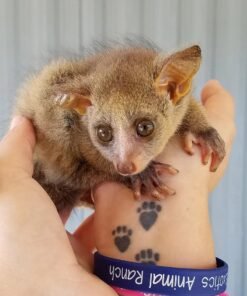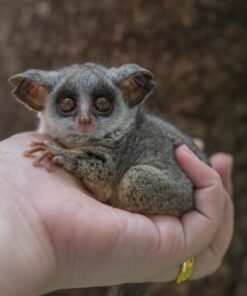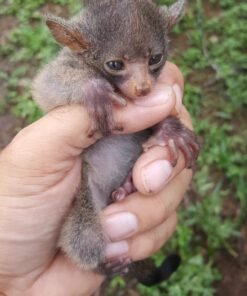Bush Babies
Bush babies, also known as galagos, are small, nocturnal primates native to Africa. They belong to the family Galagidae and are known for their agility, large eyes, and strong jumping abilities. Bush Babies, These primates are fascinating due to their unique adaptations for nocturnal life. Here is a comprehensive overview of bush babies:
General Characteristics
- Physical Appearance
- Size: Bush babies are small, with body lengths ranging from 4 to 12 inches (10 to 30 cm), excluding their tails, which can be equally long or longer. They typically weigh between 3 to 10 ounces (85 to 300 grams). FEMALE BUSHBABY
- Eyes: Large, forward-facing eyes that provide excellent night vision.
- Ears: Large, mobile ears that can move independently to detect the faintest sounds.
- Limbs: Long, strong hind limbs adapted for jumping, with opposable thumbs on their hands and feet for gripping branches.
- Diet
- Primarily insectivorous, but also consume fruits, tree gum, and small vertebrates.
- Habitat
- Found in various habitats across sub-Saharan Africa, including forests, savannas, and woodland areas.
Behavior and Ecology
- Nocturnal Lifestyle
- Bush babies are nocturnal, meaning they are active during the night and rest during the day in nests made of leaves or in tree hollows.
- Locomotion
- They are known for their incredible jumping ability, capable of leaping several times their body length from branch to branch using their strong hind legs. MALE BUSHBABY FOR SALE
- Communication
- Bush babies communicate using a range of vocalizations, including clicks, whistles, and cries. These sounds help them maintain contact with family members and signal alarm.
- They also use scent marking to communicate territory boundaries and reproductive status.
Social Structure
- Territoriality
- Bush babies are generally territorial. Both males and females maintain territories, which they mark with urine and glandular secretions.
- Social Groups
- Depending on the species, bush babies can be solitary or live in small family groups. Mothers and their offspring often form the core of these groups. MALE BUSHBABY FOR SALE
- Reproduction
- Female bush babies typically give birth once or twice a year after a gestation period of around 110-140 days.
- They usually give birth to one or two offspring, which they carry in their mouths and leave in nests while foraging.
- Young bush babies are weaned after a few months but remain with their mothers for several more months to learn essential survival skills.
Notable Species
- Southern Lesser Galago (Galago moholi)
- Habitat: Found in southern Africa in woodlands and savannas.
- Behavior: Nocturnal and arboreal, with a diet consisting mainly of insects and fruit.
- Senegal Bushbaby (Galago senegalensis)
- Habitat: Inhabits a wide range of habitats in West and Central Africa, from savannas to forests.
- Behavior: Known for its loud, distinctive vocalizations and agile movements.
- Greater Bushbaby (Otolemur garnettii)
- Habitat: Found in East Africa, in forests and coastal woodlands.
- Behavior: Larger than other bushbaby species, with a more varied diet including fruits, flowers, and small animals.
Conservation Status
- Threats
- Habitat destruction due to deforestation and agricultural expansion.
- Hunting and capture for the pet trade.
- Predation by domestic animals and introduced species.
- Conservation Efforts
- Habitat protection and restoration.
- Legal protection against hunting and trade.
- Research and monitoring of populations to understand their ecology and behavior better.
Conclusion
Bush babies are a remarkable group of primates with unique adaptations that allow them to thrive in nocturnal environments. Bush baby pet, Their agile movements, acute senses, and varied diet make them fascinating subjects of study. Conservation efforts are crucial to protect their habitats and ensure their survival in the wild. Understanding their behavior, social structure, and ecological needs is essential for developing effective conservation strategies and raising awareness about the importance of these small, yet significant, primates. BUSH BABY FOR SALE
Bush Babies
Bush Babies
Bush Babies
Bush Babies
Bush Babies





